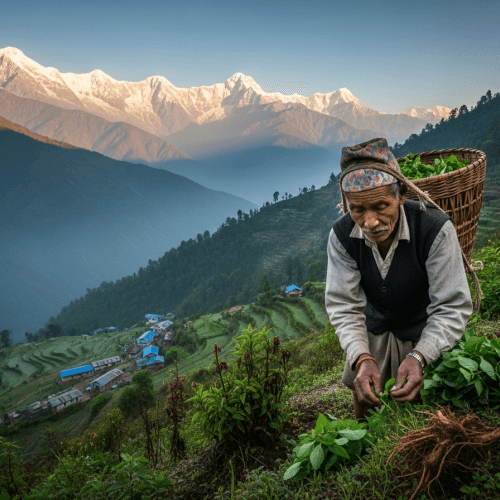
When the morning sun touches the peaks of the Mahabharata mountain range in Nepal, a world that seems to have stopped in time begins to awaken. In the higher elevations of the Himalayan foothills, where the air is clearer than crystal and every breath brings a feeling of physical and mental purification, the daily story of Ayurvedic herb gathering unfolds.
This area is not just a geographical location on a map – it is a living library of traditional Ayurvedic wisdom, where every plant has its own story and a history of use dating back as far as 5,000 years.
The Rhythm of Life in Harmony with Nature
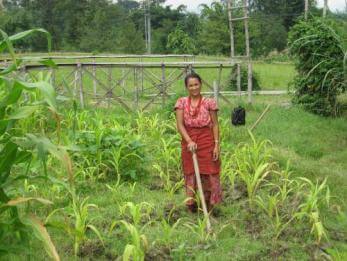 Imagine a village where time does not tick away according to the hands of a clock, but flows according to the rays of the sun and the phases of the moon. The local inhabitants still live as they did in ancient times, in harmony with the rhythm of natural cycles based on natural organic farming. The peaceful life of a mountain village does not have the technical conveniences of the modern world, and that is precisely where its greatest wealth lies. People here make do with only what they really need – and paradoxically, they have more than we do – they have time, peace, clean air, and above all, a deep understanding of nature, which surrounds them like a loving mother.
Imagine a village where time does not tick away according to the hands of a clock, but flows according to the rays of the sun and the phases of the moon. The local inhabitants still live as they did in ancient times, in harmony with the rhythm of natural cycles based on natural organic farming. The peaceful life of a mountain village does not have the technical conveniences of the modern world, and that is precisely where its greatest wealth lies. People here make do with only what they really need – and paradoxically, they have more than we do – they have time, peace, clean air, and above all, a deep understanding of nature, which surrounds them like a loving mother.
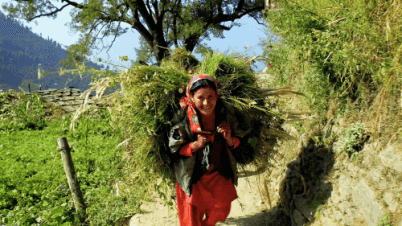 Mountain Pilgrims with Treasures of Nature
Mountain Pilgrims with Treasures of Nature
People living in remote mountain areas also regularly visit the villages in the foothills of the Himalayas, bringing fresh harvests of wild herbs to sell for further processing. These mountain pilgrims are like living bridges between the majestic kingdom of nature and the bustling world of village people. Their arrival is always an event—they bring not only herbs, but also stories from places that ordinary people never get to see.
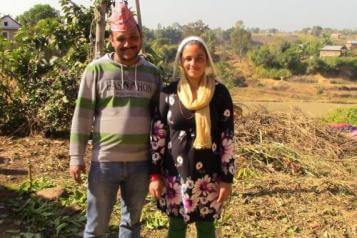 Such as Mohan Bandhari and his family, who live in the Tulsipur region of western Nepal, where a large number of important plants grow. One of these, which Bandhari harvests with respect, is adhatoda vasica—an herb that has excellent and wide-ranging effects on respiratory health. Holding it in his hands, he explains:
Such as Mohan Bandhari and his family, who live in the Tulsipur region of western Nepal, where a large number of important plants grow. One of these, which Bandhari harvests with respect, is adhatoda vasica—an herb that has excellent and wide-ranging effects on respiratory health. Holding it in his hands, he explains: 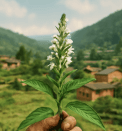 "This plant is my old friend. I have known it since childhood, and it knows me. I know when it is ready to be harvested and how to process it properly." His words reflect the deep relationship between humans and nature, which is becoming a rarity in our modern world.
"This plant is my old friend. I have known it since childhood, and it knows me. I know when it is ready to be harvested and how to process it properly." His words reflect the deep relationship between humans and nature, which is becoming a rarity in our modern world.
Jawahar Lal Sah: A True Herbal Expert
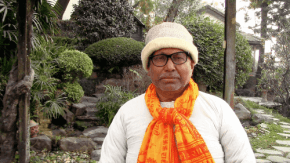 Jawahar Lal Sah has been growing herbs and agricultural crops since he was 13 years old, when he lived in the village of Barahathawa in the Sarlahi region of southern Nepal. He now lives in Kathmandu, where, in collaboration with Ayurvedic physician Dr. Kam Dev Jha and his two sons, he has gradually developed the handmade production of Everest Ayurveda Ayurvedic herbal teas.
Jawahar Lal Sah has been growing herbs and agricultural crops since he was 13 years old, when he lived in the village of Barahathawa in the Sarlahi region of southern Nepal. He now lives in Kathmandu, where, in collaboration with Ayurvedic physician Dr. Kam Dev Jha and his two sons, he has gradually developed the handmade production of Everest Ayurveda Ayurvedic herbal teas.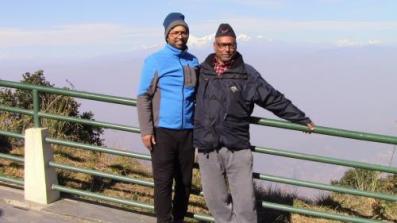
He is a true expert in selecting and assessing the quality of herbs. When you watch him at work, you can see how his experienced eyes and hands recognize the quality of each plant at first glance and touch. A thorough knowledge of the medicinal properties of their individual parts is the basis of Ayurvedic medicine, and true herbal experts such as Jawahar Lal are therefore people who still live in close proximity to nature and know where to find which herbs and of what quality.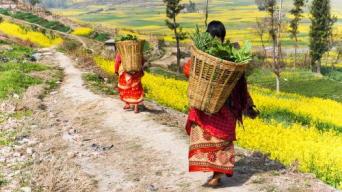
Jawahar Lal has been working with Bandhari for many years. They know each other well, and Bandhari supplies him with herbs of the highest quality. For Ayurvedic blends, Jawahar Lal also uses lemongrass, tulsi, and mint from the fertile plains on the border between Nepal and India, while other herbs are sourced from gatherers in the Dang region, which has an almost tropical climate in the southwest of the country. Another important area, Sankhu, is located northeast of Kathmandu. The Sarlahi region in the south of the country, as well as 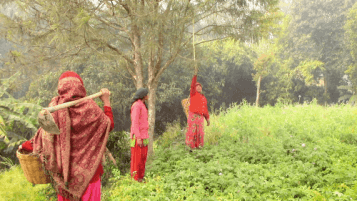 local herb markets are another source of the rich variety of herbs used to produce Himalayan Ayurvedic teas. Some of these plants are also grown by local people on their fields using traditional methods without the use of any chemical fertilizers.
local herb markets are another source of the rich variety of herbs used to produce Himalayan Ayurvedic teas. Some of these plants are also grown by local people on their fields using traditional methods without the use of any chemical fertilizers.
„All herbs come from pure nature, which is a manifestation of God. Generous Mother Nature offers us her riches in the form of medicinal plants in the Pahár jungle,“ says Jawahar Lal with reverence in his voice. These words are not just a poetic metaphor—they express a deep spiritual connection to nature, which is the basis of the entire Ayurvedic approach.
The Ritual of Drying and Hand Cleaning
Before any herb is used for further processing, Jawahar Lal and his team first spread it out on the terrace of their herbal production facility so that it can dry thoroughly in the sun and no moisture remains. Nepalese women then clean the herbs by hand and prepare them for use in Ayurvedic mixtures. Their work is extremely careful; they spread each herb on a straw tray and manually remove unwanted parts of the plants. First, one woman cleans the herb, then passes the tray on to a second woman for inspection, and then to a third woman before the herb is ready to be mixed with other herbs. Finely ground impurities are then removed by lightly tossing the entire contents of the tray into the air in the spirit of Ayurvedic wisdom - "what is weightless will fly away, what is valuable will be preserved." Each movement is thus a true ritual.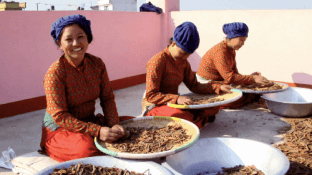
"I am happy to have been working here for nine years. I like how we share our production together, as if we were one family," says Sangeeta Rajthala with a smile. Her words capture the atmosphere in which Ayurvedic teas are prepared.
Suresh Sah: A Bridge between Ayurvedic Tradition and Modern Science
His son, Suresh Sah, represents a new generation that can combine the traditional millennial wisdom of Ayurvedic medicine with the knowledge of modern science. He grew up in a small Nepalese village and, after completing an English-speaking school, moved to Banaras in India, one of the oldest cities in the world, where he continued his studies at high school. He then began studying biotechnology at the University of Pune.
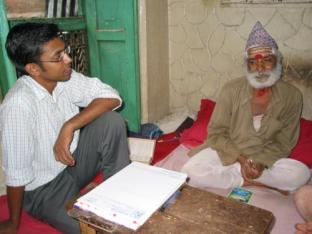
During this period, he met Dr. Kam Dev Jha, who created herbal tea recipes. "He was a very wise man, a true scholar. He had real insight, which is why his recipes are so effective and simple, making them easy to use without a doctor's prescription," Suresh recalls with respect for the esteemed doctor at Naradevi Ayurvedic Hospital and former advisor to the Nepalese Ministry of Health.
By completing his studies in biotechnology, Suresh gained a good knowledge of all the processes taking place in the human body, including microbiology, biochemistry, and plant biotechnology. He then began working at an Ayurvedic clinic in Pune to expand his knowledge and gain more experience in Ayurveda. He learned many things, such as how an Ayurvedic doctor makes a diagnosis, and became familiar with procedures and therapies that are beyond the knowledge and practice of conventional Western medicine.
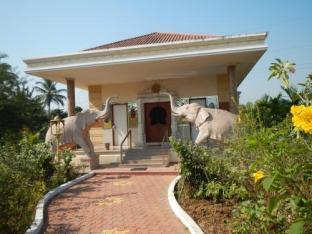
Dr. Kam Dev Jha's experience, combined with the knowledge he gained during his studies and practical work at an Ayurvedic clinic, has given him a solid foundation for a deeper understanding of the human body and Ayurvedic medicine. This enables him to prepare effective herbal mixtures that work very well and combine the millennia-old wisdom of Ayurveda with modern scientific knowledge. Despite his modern knowledge, he maintains a very cordial approach in his work:
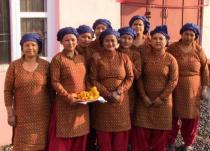
„Our most important task is to first ensure that we collect the highest quality herbs, mainly in Nepal. Then comes the process of cleaning them. We do this in a very natural and traditional way. To be honest, when we prepare teas, we don't think about producing a product, but simply do it with the feeling that we are preparing food for the whole family in the kitchen. That is why our tea production is imbued with the love of the people who prepare it," explains Suresh.
The Long Journey to Your Cup
Once the ground parts of the individual herbs are ready, they are mixed according to prepared recipes. The mixtures are poured by hand into bags, which are then carefully placed into folded paper boxes and put into wooden crates.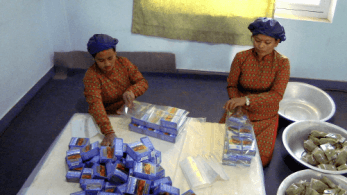
Then begins their long journey by truck from Kathmandu to Kolkata, and then by ship around Sri Lanka, through the Suez Canal and the Strait of Gibraltar to the port of Hamburg. From there, it is only a short distance by freight train to Prague.
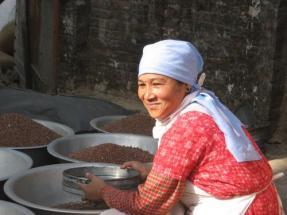 So, the next time you brew a cup of Ayurvedic tea, remember all the hands, hearts, and souls that went into making it. Every sip contains the authentic power of the Himalayan mountains, the love of Nepalese families, and the millennia-old wisdom of Ayurvedic medicine.
So, the next time you brew a cup of Ayurvedic tea, remember all the hands, hearts, and souls that went into making it. Every sip contains the authentic power of the Himalayan mountains, the love of Nepalese families, and the millennia-old wisdom of Ayurvedic medicine.

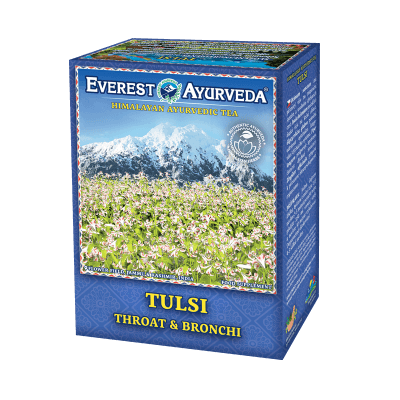 100 g
100 g 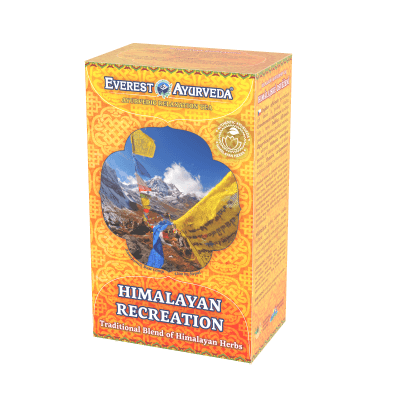 100 g
100 g 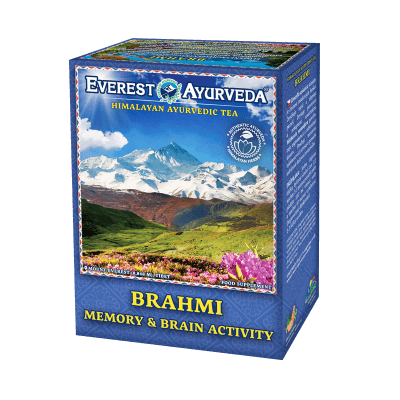 100 g
100 g 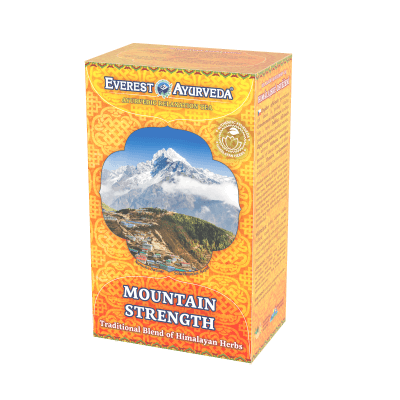 100 g
100 g